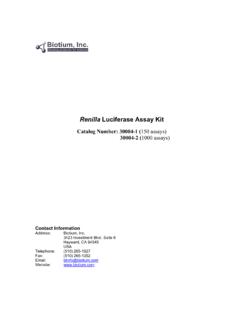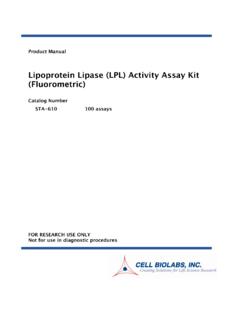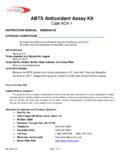Transcription of Wieslab Alport's Syndrome kit - Eagle Biosciences
1 200 - 400 ALP 105 RUO Instruction Wieslab Alport's Syndrome kit Immunohistochemical staining of type IV collagen in Alport's Syndrome Store the kit at +2-8 C Document No. E-23- 0175-06 RUO August, 2013 For Research Use Only. Not for use in diagnostic procedures. ALP 1 05 RUO, E-23-0175- 06 RUO 2 PURPOSE OF RESEARCH PRODUCT Immunohistochemical staining kit for indirect detection of mutations in the gene for the alfa 5 chain of type IV collagen in Alport s Syndrome . The result shall not be used for clinical diagnosis or patient management. SUMMARY AND EXPLANATION Alport Syndrome have mutations in the gene for the alfa 5 chain of type IV collagen.
2 This results in a lack of the alfa 5 (IV) chain from glomerular basement membrane (GBM) and the skin basement membrane as well as a lack of the alfa 3 (IV) chain from GBM. WARNINGS AND PRECAUTIONS - For Research Use Only. Not for use in diagnostic procedures. KIT COMPONENTS AND STORAGE OF REAGENTS 200 l Mouse monoclonal antibody to alfa 1 chain of type IV collagen (MAB 1) 200 l Mouse monoclonal antibody to alfa 3 chain of type IV collagen (MAB 3) 100 l Rat monoclonal antibody to alfa 5 chain of type IV collagen (MAB 5) 1 x 23 mL Glycine/urea solution (Store in a freezer, since the urea is slowly disintegrating). Note! MAB 5 is a rat monoclonal antibody. T wo detection systems are needed: For MAB 1 and MAB 3 a Mouse-detection system and for MAB 5 a Rat-detection system.
3 See table 1 and 2 below for recommended dilutions for both cryostate sections and paraffin-embedded tissue. Table 1. Cryostate sections (Method 1) Monoclonal Antibody Dilution Detection system MAB 1 1:25 Anti-Mouse-FITC MAB 3 1:25 Anti-Mouse-FITC MAB 5 1:50 Anti-Rat-FITC Table 2. Paraffin-embedded tissue sections (Method 2) Monoclonal Antibody Dilution Detection system MAB 1 1:50 Anti-Mouse polymer detection system MAB 3 1:50 Anti-Mouse polymer detection system MAB 5 1:100 Anti-Rat polymer detection system ALP 1 05 RUO, E-23-0175- 06 RUO 3 METHOD 1 CRYOSTATE SECTIONS Staining method for type IV collagen alfa-1 (MAB 1), alfa-3 (MAB 3) and alfa-5 (MAB 5) using Wieslab Alport s Syndrome Immunohistochemical staining kit (Euro-Diagnostica) on cryostate sections.
4 Staining of cryostate sections by monoclonal antibodies 1. For each tissue specimen to be analyzed, cut three 3 m thick cryostate sections, air dr y and fix in acetone for 10 minutes. 2. Wash the three slides in PBS for 5 minutes and leave the MAB 1 and MAB 3 slides in PBS. 3. MAB 5 slide only: The section to be stained with MAB 5 is incubated in the glycine/urea solution (provided with the Wieslab kit) for 5 min at 4-6 C. 4. MAB 5 slide only: Wash in sterile PBS for 10 min. 5. Incubate the three tissue slides for 1 hour with their respective monoclonal antibody: a. MAB 1 (dilut ed 1:25) b. MAB 3 (diluted 1:25) c. MAB 5 (diluted 1:50). 6. Wash in sterile PBS for 10 minutes. 7.
5 Incubate the three tissue slides for 1 hour with their respective FITC -labelled secondary antibodies: a. MAB 1 and MAB 3 tissue slides with Anti -M ouse FITC b. Note! MAB 5 tissue slide with Anti -R at FITC 8. Wash in sterile PBS for 10 minutes and add mounting media containing p-phenylene diamine to delay fluorescence quenching. METHOD 2 PARAFFIN-EMBEDDED TISSUE SECTIONS Staining method for type IV collagen alfa-1 (MAB 1), alfa-3 (MAB 3) and alfa-5 (MAB 5) using Wieslab Alport s Syndrome Immunohistochemical staining kit (Euro-Diagnostica) on formalin-fixed, paraffin-embedded tissue sections. Staining of formalin-fixed, paraffin-embedded tissue sections by monoclonal antibodies 1.
6 For each tissue specimen to be analyzed, cut five 3- 4 m thick formalin-fixed, paraffin-embedded tissue sections, deparaffinise and rehydrate. 2. Antigen demasking: Microwave boiling in citrate buffer, pH 2 at 750W for 8 min followed by 350W for 15 min. Use citrate buffer pH6 (Dako S2031) adjusted with 1M HCl. 3. Rinse the five slides in distilled water for 2 minutes. MAB 1, MAB 3 and negative control slides proceed to step 6. 4. MAB 5 slide only: The section to be stained with MAB 5 is incubated in the glycine/urea solution (provided with the Wieslab kit) for 10 min at 4-6 C. 5. MAB 5 slide only: Rinse in distilled tap water for 2 x 2 min. 6. Endogenous peroxidases are blocked by incubating the three slides H2O2 in TBS for 10 min.
7 7. Rinse the the five slides in tap water for 5 min, followed by distilled water for 1 minute 8. Incubate the three tissue slides for 1 hour with their respective monoclonal antibody: a. MAB 1 (diluted 1:50) b. MAB 3 (diluted 1:50) c. MAB 5 (diluted 1:100). d. Negative control, mouse (PBS) e. Negative control, rat (PBS) 9. Rinse the three slides in distilled water for 1 minute 10. Finalise the staining of the three tissue slides according to the instructions of your respective detection systems: a. MAB 1 and MAB 3 tissue slides with the Anti -M ouse detection system b. Note! MAB 5 tissue slide with the Anti -R at detection system ALP 1 05 RUO, E-23-0175- 06 RUO 4 INTERPRETATION OF STAINING For proper interpretation a negative (without primary antibody) and a positive control (MAB 1) should be run alongside specimens.
8 The positive control serves to indicate that specimen processing and staining were carried out correctly and should show intense staining along basement membranes, in the glomerulus mainly to the mesangial matrix and the subendothelial aspects of the GBM. The negative control serves to assess non-specific staining which should be taken into consideration when interpreting results. MAB 3 and MAB 5 normally stain the entire thickness of the glomerular basement membrane as well as the distal tubular BM. In Alport families with X-linked disease the MAB 3 and MAB 5 staining are absent in males and have a discontinuous distribution in females. The findings can be seen in 60-70% of the families. In autosomal recessive subjects staining of MAB 5 is seen on Bowmans capsule and collecting ducts BM while MAB 3 is negative.
9 MAB 3 is not normally found in the skin while MAB 5 stains the epidermal basement membrane. This staining is usually lacking in X-linked male subjects while females exhibit a segmental distribution of the antigen. In autosomal recessive subjects staining of MAB 5 is normal on the epidermal basement membrane. DOCUMENTATION The following staining patterns will be obtained on the respective basement membranes. Normal Alport dominant Alport recessive kidney skin kidney skin kidney Skin MAB 1 + + + + + + MAB 3 + - - - - - MAB 5 + + - - -* + * anti - 5 staining is seen on Bowmans capsule and collecting ducts basement membrane. REFERENCES Kashtan C. Alport Syndrome and skin basement membrane disease, Curr Diagn Path 8, 349-360, 2002.
10 Gubler MC et al. Autosomal recessive Alport Syndrome : immunohistochemical study of type IV collagen chain distribution. Kidney Int. 47:1142-1147, 1995. Kashtan C. Alport Syndrome : Is diagnosis only skin deep? Kidney Int 55, 1575-1576,1999. Piron Y. Making the diagnosis of Alport s Syndrome , Kidney Int 56, 760-775, 1999. Martin P. Type IV collagen. Characterization of the COL4A5 gene, mutations in Alport Syndrome , and autoantibodies in Alport and Goodpasture syndromes. PhD Thesis Oulu University, Finland, 2000. ALP 1 05 RUO, E-23-0175- 06 RUO 5 EXPLANTATION OF SYMBOLS. Use -by date Biological risks Temperature limit Manufacturer. Batch code. Catalogue number. Consult instructions for use.









